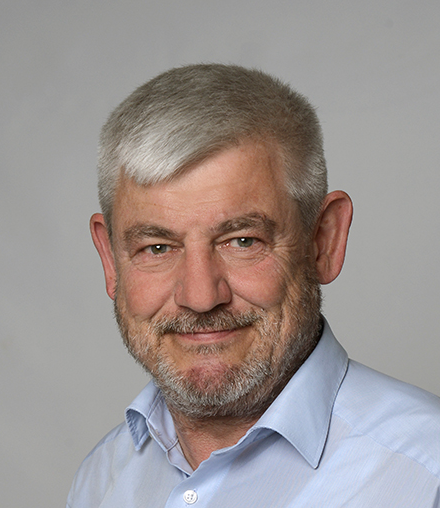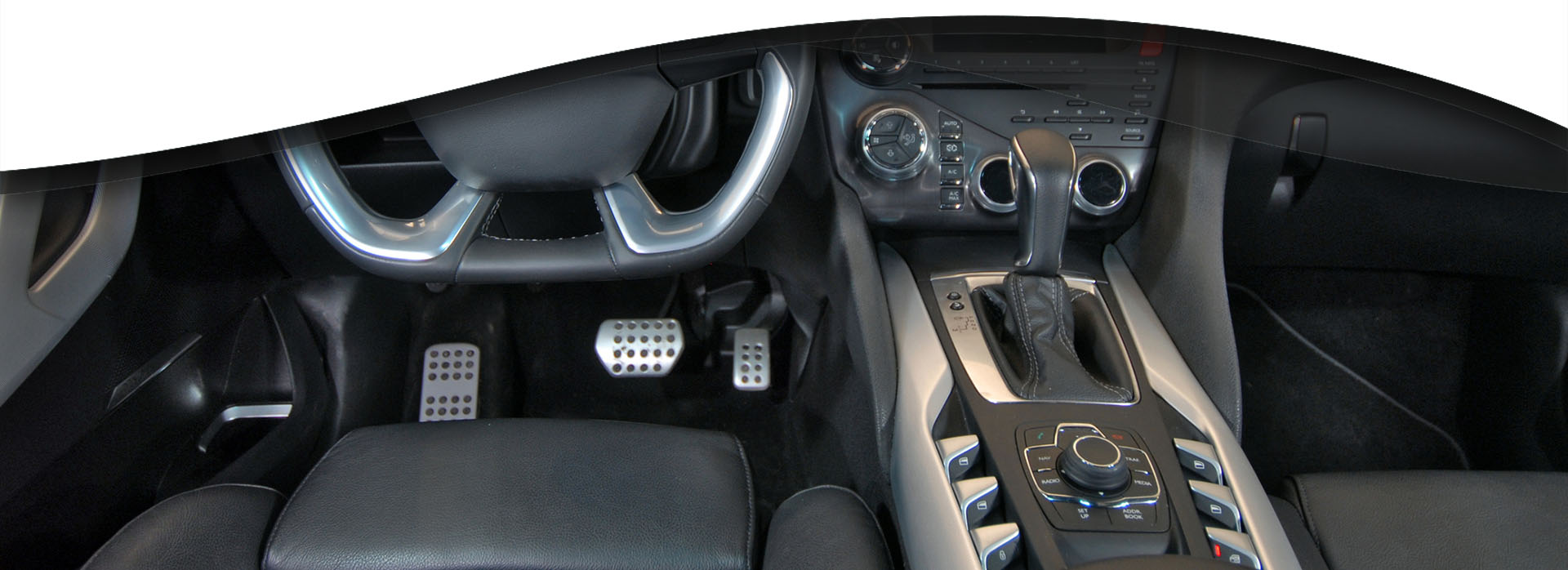Paul Heisterkamp

Short CV
Born in 1957, I received an MA in German Linguistics, General Linguistics and Philosophy from Westfälische
Wilhelms Universität, Münster, in 1986. I entered the (then) AEG (later Daimler-Benz AG) research group on
pattern recognition and speech in 1987. First working on lexica for speech recognition, I became responsible
for spoken dialogue research with the start of the SUNDIAL EU project in 1988. I contributed in several
internal and external projects to the development and market release of ‚Linguatronic’ by Mercedes-Benz in
1996, the first voice control in the car. My further research work in national, European and US research
projects (DARPA Communicator and AUGmented COGnition) is documented in the publications list below.
My internal work is perhaps best reflected in the list of the patent applications . Maybe you find some hidden
gems there!
For decades now, I serve the scientific speech and dialogue community in committees (e.g. Stevin, ELRA) and
conference review boards (e.g. IWSDS, Interspeech, ICASSP).
Basics
Let me share with you my basic approach: Before you think of how to interact with a ‚function‘ of a technical system, first, try to find out what the real underlying need is. And: All interaction has to be dialogic in nature. When you come into a dark room, you want to be able to see! The idea of ‚Switching on the light‘ is only natural in that you have learned that this might help with your problem (from Heisterkamp 2003, p. 2898f.):
A person comes into a dark room. The person wants to be able to see. For us today, we think it natural to tap with our hands in the region next to the door to find the light switch. We
find a switch, we press it, the light goes on and our problem is solved. Around the end of the 19th century, this behavior was by no means ‘natural’, as witnessed by [a sign,
reportedly found in New York City hotels rooms at that time], saying: „This room is equipped with Edison Electric Light. Do not attempt to light with match! Simply press the switch
on the wall by the door.“ (cf. Mijksenaar, Paul; Westendorp, Piet (1999): Open Here – The Art of Instructional Design. New York.)
In terms of human-machine dialog, the process of ‘switching on the light’ in our modern sense implies a number of assumptions that have developed over time, and, just as a pidgin
contact language becomes a creole language in its own right when it has native speakers, for those who have grown up with this process as the normal way to solve the problem of the dark room, this process is the standard and may well be called natural without quotation marks: Every child can do it, and you do not have to understand any of the technology or
the details involved.
The ‘switching on the light’ process is a dialog: if the designer of the system obeyed the conversation conventions, the presence of a switch in one of the habitual locations can be seen as a communicative act (system-driven, so to speak), offering a communication: “If you have a darkness-problem, interact with me, and I’ll solve it” The communicative act of pressing the switch equals an acceptance of this offer. If the light does not come on (the confirmation act), you can observe what this ‘broken promise’ in communication does to people: A very normal first reaction is to press the switch again and again, and with more energy, i.e. to repeat the communication act with more emphasis. Only later do they start to question the dialog assumptions, e.g. look for another switch or check (using other switches) whether power is available (and finally insert that hotel key card in that box in the dark), etc. Switching on the light is easy – a very easy interface to an enormous and complex energy supply system, but, just as this system, the dialog is not natural! At least in the beginning, it had to be learned, i.e. the deployers of the system (Edison!) had to teach their potential customers (guests in the hotel could have b{r}ought a candle!) how to access their services. The advantages of electric light over the other means available at that time (notably gas) convinced people fast, so that for us, the native ‘electric light creole’ speakers, all this seems completely natural. Of course, there are dialects of this language: For a European, finding and operating the turning switch of an American bedside table lamp, near the bulb and often obscured by the lamp shade, or for an American finding the switch of a European bedside table lamp attached to the cable and slipped behind the bedside table can be a several minutes exercise. The existence of these dialects demonstrates that even here, in a relatively short period of time and keeping the same conversation maxims, the Saussurean arbitrarity of the sign has given way to conventions.
People want to have their problems go away - they want a „WHAT“. Technical systems require dedicated instructions - they need a „HOW“. So far, in order to bridge the gap between WHAT and HOW, it is mostly that the humans have to learn the HOW-part. They become operators of technical system that as a reward solves a problem. I see it as a constant task for engineering to alleviate the burden of the HOW-part further and further. People shouldn’t need to go to a school of magic to achieve magical results. Focus on the problems people really have, and try to bring the solution paths into they world! Let me help you help your customers get things done!
Some of the assumptions in the dialog between the system (light/switch) and the user are:
- A room has an electric light
- The light is operated by a switch
- The switch is in the room or outside near the door
- A switch in the room near the door ‘belongs’, or is connected to, the light in that room
- The light is working (bulb, power, cables etc.)
The ‘switching on the light’ process is a dialog: if the designer of the system obeyed the conversation conventions, the presence of a switch in one of the habitual locations can be seen as a communicative act (system-driven, so to speak), offering a communication:
“If you have a darkness-problem, interact with me, and I’ll solve it” The communicative act of pressing the switch equals an acceptance of this offer. If the light does not come on (the confirmation act), you can observe what this ‘broken promise’ in communication does to people: A very normal first reaction is to press the switch again and again, and with more energy, i.e. to repeat the communication act with more emphasis. Only later do they start to question the dialog assumptions, e.g. look for another switch or check (using other switches) whether power is available (and finally insert that hotel key card in that box in the dark), etc.
Publications
Alexandersson, Jan; Heisterkamp, Paul (2000): Some Notes on the Complexity of Dialogues. In: Dybkjaer, Laila; Hasida, Koiti; Traum, David (Eds.): Proceedings of the ACL 2000 Workshop “1st SIGdial Workshop on Discourse and Dialogue“, Hong Kong, 2000.
André, Elisabeth; Dybkjaer, Laila; Heisterkamp, Paul; Minker, Wolfgang (Eds.) (2002): Proceedings of the ISCA Tutorial and Research Workshop on Interactive Dialogue in Multi–Modal Systems (IDS-02): Multi-Modal Dialogue in Mobile Environments. Kloster Irsee, Germany, 17-19 June 2002 (CD-ROM)
André, Elisabeth; Dybkjaer, Laila; Minker, Wolfgang; Heisterkamp, Paul (Eds.) (2004): Affective Dialogue Systems. Tutorial and Research Workshop, ADS 2004. Kloster Irsee, Germany, June 14-16, 2004. Proceedings. Berlin, Heidelberg, New York: Springer. (Lecture Notes in Artificial Intelligence. LNAI 3068).
Auriol, Eric; Fressmann, Andrea; Heisterkamp, Paul; Aaberg, Ingvar; Diamond, Ben; Taylor, Brian (2005): AMIRA: Supporting Diagnostics And Decisions In Safety-Critical Incidents. In: Proceedings of eChallenges 2005, Ljubljana, Slovenia, 2005.
Bayer, Thomas; Heisterkamp, Paul; Mecklenburg, Klaus; Renz, Ingrid; Regel-Brietzmann, Peter; Kaltenmeier, Alfred; Ehrlich, Ute (1995): Natürliche Sprache - ein multimedialer Träger von Information. InfoPort - ein Projekt zur Überbrückung von Medienbrüchen. In: Proceedings of DAGM-95, Bielefeld, Germany, 1995.
Boros, Manuela; Ehrlich, Ute; Heisterkamp, Paul; Niemann, Heinrich (1998): An evaluation framework for spoken language processing. In: Proceedings of SPECOM '98, St. Petersburg, Russia, 1998.
Boros, Manuela; Heisterkamp, Paul (1999a): Efficient and robust natural language processing in simple speech application domains. In: Dalsgaard et al. (Eds.) (1999).
Boros, Manuela; Heisterkamp, Paul (1999b): Linguistic phrase spotting in a simple application spoken dialogue system. In: Proceedings of Eurospeech '99, Budapest, Hungary, 1999.
Brey, Thomas; Hanrieder, Gerhard; Regel-Brietzmann, Peter; Heisterkamp, Paul; Hitzenberger, Ludwig (2000): Issues in the Evaluation of Spoken Dialogue Systems: Experience from the ACCeSS Project. Proceedings of the Second International Conference on Language Resources and Evaluation (LREC-200), Athens, Greece, 2000.
Brietzmann, Astrid; Class, Fritz; Ehrlich, Ute; Heisterkamp, Paul; Kaltenmeier, Alfred; Mecklenburg, Klaus; Regel-Brietzmann, Peter; Hanrieder, Gerhard; Hiltl, Waltraud (1994): Robust speech understanding. In: Proceedings of ICSLP '94, Yokohama, Japan, 1994.
Bühler, Dirk; Vignier, Sébastien; Heisterkamp, Paul; Minker, Wolfgang (2003): Safety and operating issues for mobile humanmachine interfaces. In: Proceedings of Intelligent User Interfaces, Miami, Fl., 2003.
Dalsgaard, Paul; Lee, Chin-Hui; Heisterkamp, Paul; Cole, Ron (Eds.) (1999): Proceedings of the ESCA Tutorial and Research Workshop on Interactive Dialogue in Multi–Modal Systems. Kloster Irsee, Germany, 22-25 June 1999.
Dybkjær, Laila; Bernsen, Niels Ole; Carlson, Rolf; Chase, Lin; Dahlbäck, Niels; Failenschmid, Klaus; Heid, Ulrich; Heisterkamp, Paul; Jönsson, Arne; Kamp, Hans; Karlsson, Inger; Kuppevelt, Jan van; Lamel, Lori; Paroubek, Patrick; Williams, David (1998): The DISC Approach to Spoken Language Systems Development and Evaluation. In: Proceedings of the First International Conference on Language Resources and Evaluation (LREC), Granada, Spain, May 1998.
Ehrlich, Ute; Hanrieder, Gerhard; Hitzenberger, Ludwig; Heisterkamp, Paul; Mecklenburg, Klaus; Regel-Brietzmann, Peter (1997): ACCeSS - Automated Call Center Through Speech Understanding System. In: Proceedings of Eurospeech '97, Rhodes, Greece, 1997.
Hanrieder, Gerhard; Heisterkamp, Paul (1994): Robust analysis and interpretation in speech dialogue. In: Niemann, Heinrich; de Mori, Renato; Hanrieder, Gerhard (Eds.): Progress and prospects of speech research and technology. Proceedings of the CRIM/Forwiss Workshop, 5-7 September 1994, Munich, Germany. St. Augustin: Infix. (Proceedings in Artificial Intelligence. 1.).
Hanrieder, Gerhard; Heisterkamp, Paul; Brey, Thomas (1998): Fly with the EAGLES: Evaluation of the "ACCeSS" Spoken Language Dialogue System. In: Proceedings of ICSLP-98, Sydney, Australia, 1998.
Heisterkamp, Paul (1993): Ambiguity and uncertainty in spoken dialogue. In: Proceedings of Eurospeech '93, Berlin, Germany, 1993.
Heisterkamp, Paul (1996): Natural language analysis and generation. Materials of the course held at the 4th European Summer School on Language and Speech Communication – Dialogue Systems. Budapest, Hungary. [The same as Daimler-Benz AG, Technischer Bericht F3-96-016. Company Internal Report].
Heisterkamp, Paul (1997a): Speech Dialogue and Corpora. In: ELRA Newsletter, Vol. 2, No. 1, March 1997.
Heisterkamp, Paul (1997b): Thinking in systems. An overview of dialogue system design, components and their interaction. Three lectures held at the Royal Technical University (KTH), Stockholm, Sweden, 10-12 Nov. 1997.
Heisterkamp, Paul (1997c): Semantikrepräsentation und Kontextuelle Interpretation in InfoPort-S. Zur Klärung des Verhältnisses von Belief Module, SIL und Rigid Dialogue. Daimler-Benz AG, Technischer Bericht F395-017. [Company Internal Report].
Heisterkamp, Paul (1999): Time to get real: Current and future requirements for generation in speech and natural language from an industrial perspective. In: Becker, Tilman; Busemann, Stephan (Eds.): “May I speak freely? Between templates and free choice in Natural Language Generation: What is the right NLG technology for my application? Proceedings of the NLG Workshop in conjunction with KI-99, Bonn, Germany, 1999.
Heisterkamp, Paul (2001a): Linguatronic: Product-Level Speech System for Mercedes-Benz Cars. In: Proceedings of Human Language Technology (HLT2001), San Diego, Ca. 2001.
Heisterkamp, Paul (2001b): Driving forces in the development of speech technology: Safety. Invited talk for a panel discussion at the IEEE Workshop on Automatic Speech Recognition and Understanding (ASRU 2001), Madonna di Campiglio, Italy, 2001.
Heisterkamp, Paul (2002): In-vehicle Spoken Dialog: Safety and functionality. Invited talk at LangTech 2002, Berlin, Germany, 2002. (With slight variations also held at Voice Enabled Services, London, 2003).
Heisterkamp, Paul (2003): “Do not attempt to light with match!”: Some thoughts on progress and research goals in Spoken Dialog Systems. Invited talk at Eurospeech ’03 ELSNET Special Session on Roadmaps for Speech and Language Technology, Geneva, Switzerland, 2003.
Heisterkamp, Paul (2008): Speak to the Target Audience – Some Observations and Notes on the Pragmatics of Spoken Dialog Systems. In: Hempel, Thomas (Ed.): Usability of Speech Dialog Systems. Listening to the Target Audience. Berlin, Heidelberg, New York: Springer. (Signals and Communication Technology).
Heisterkamp, Paul; Bourgeois, Julien; Freudenberger, Jürgen; Linhard, Klaus; Lacot, Xavier; Masson, Guillaume (2005): “Look who’s talking”: Audio Monitoring and Awareness of Social Context. In: Proceedings of HCII/ AugCog International, Las Vegas, Nv., 2005.
Heisterkamp, Paul; Kincses, Wilhelm-Emil (2003): Don‘t talk to the Driver! Situated Dialog in the vehicle. Invited talk at European ACL 2003 Dialog Workshop, Budapest, Hungary, 2003.
Heisterkamp, Paul; McGlashan, Scott (1996): Units of dialogue management: an example. In: Proceedings of ICSLP-96, Philadelphia,Pa., 1996.
Heisterkamp, Paul; McGlashan, Scott; Youd, Nick (1992): Dialogue semantics for an oral dialogue system. In: Proceedings of ICSLP-92, Banff, Alberta, Canada, 1992.
Linhard, Klaus; Heisterkamp, Paul (2003): Acoustics aspects of in-vehicle spoken dialogue. Invited talk at DAGA 03, Aachen, Germany, 2003.
Mann, Sandra; Berton, André; Dausend, Marcel; Heisterkamp, Paul (2008): “Beethoven’s Ninth” – An experiment on naming usage for audio files. In: Proceedings of the 19th Conference ‘Elektronische Sprachsignalverarbeitung’ (ESSV), Dresden, Germany, 2008.
Mann, Sandra; Heisterkamp, Paul; Hüning, Harald; Jersak, Thomas; Kronenberg, Susanne (2006): How to Systematically Store and Retrieve Voice-enrolled List Elements in Spoken Dialogue Systems. In: Proceedings of the 17th Conference ‘Elektronische Sprachsignalverarbeitung’ (ESSV), Freiberg, Germany, 2006.
McGlashan, Scott; Fraser, Norman M.; Gilbert, G. Nigel; Bilange, Éric; Heisterkamp, Paul; Youd, Nick (1992): Dialogue management for telephone information systems. In: Proceedings of the 3rd Conference on Applied Natural Language Processing, Trento, Italy, 1992.
Mecklenburg, Klaus; Hanrieder, Gerhard; Heisterkamp, Paul (1995): A Robust parser for continuous spoken language using PROLOG. In: Proceedings of Natural Language Understanding and Logic Programming, Lisbon, Portugal, 1995.
Minker, Wolfgang; Haiber, Udo; Heisterkamp, Paul; Scheible, Sven (2002): Intelligent dialogue strategy for accessing infotainment applications in mobile environments. In: André et al. (Eds.), 2002.
Minker, Wolfgang; Haiber, Udo; Heisterkamp, Paul; Scheible, Sven (2003): Intelligent dialog overcomes speech technology limitations: the SENECa example. In: Proceedings of Intelligent User Interfaces, Miami, Fl., 2003.
Minker, Wolfgang; Haiber, Udo; Heisterkamp, Paul; Scheible, Sven (2004): The SENECA Spoken Language Dialogue System. In: Speech Communication 42/1-2, 2004.
Minker, Wolfgang; Haiber, Udo; Heisterkamp, Paul; Scheible, Sven (2005): Design, Implementation and Evaluation of the SENECA Spoken Language Dialogue System. In: Minker, Wolfgang; Bühler, Dirk; Dybkjaer, Laila (Eds.): Spoken Multimodal HumanComputer Dialogue in Mobile Environments. Dordrecht: Springer. (Text, Speech and Language Technology 28). [Extended version of Minker et al. (2004); reprinted with permission].
Poller, Peter; Heisterkamp, Paul (1997): A compact representation of prosodically relevant knowledge in a speech dialogue system. In: Proceedings of the Workshop on Concept-to-Speech Generation Systems, ACL'97/EACL'97 Joint Conference, Madrid, Spain, 1997.
Poller, Peter; Heisterkamp, Paul; Stall, David (1996): An interface protocol from the speech generator to the speech synthesis module of a dialogue system. In: Bateman, John A. (Ed.): Speech Generation in Multimodal Information Systems and its Practical Applications. Proceedings of the 2nd 'SPEAK!' Workshop (2nd-3rd November 1996 [recte 1995]). St. Augustin: GMD. (GMDStudien. 302.).
Schneider, René; Heisterkamp, Paul (2002): Connecting mobile dialogue systems to the world wide web. In: André et al. (Eds.), 2002.
Patent Applications
either alone or together with colleagues; some are granted, some have expired, but all are public!
Contents
Title
Publication Date & PDF
Download PDF
Download PDF
Download PDF
Download PDF
Download PDF
Download PDF
Download PDF
Download PDF
Download PDF
Download PDF
What else can I help you with?
I'm happy to answer questions! Please contact me!





